Hyundai Accent: Cylinder Block / Cylinder Block

• Use fender covers to avoid damaging painted surfaces.
• To avoid damage, unplug the wiring connectors carefully while holding the connector portion.

• Mark all wiring connector and hoses to avoid misconnection.
• To release the fuel system pressure before removing the engine assembly, start the engine without fuel pump relay. Then, switch "OFF" the ignition when engine stops.
• Turn the crankshaft pulley so that the No. 1 piston is at top dead center.
1.Remove the engine and transaxle assembly. (Refer to Engine and Transaxle Assembly - "Engine and Transaxle Assembly")
2.Remove the harness clamp from the wiring connector around the engine and transaxle and remove the connector bracket.
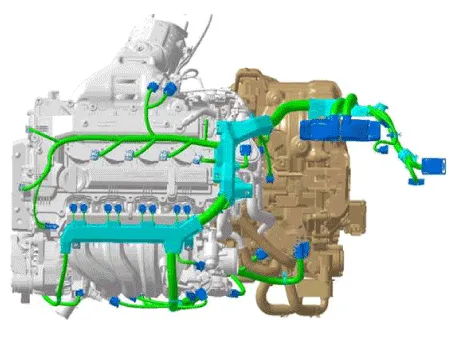
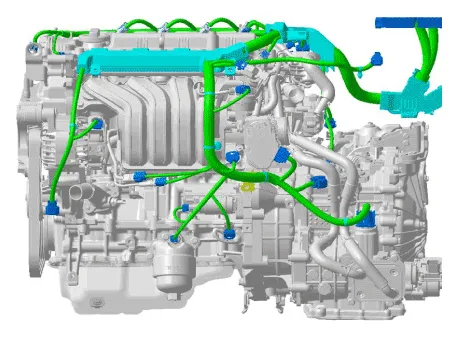
3.Remove the transaxle assembly from the engine assembly.Intelligent variable transmission (IVT)(Refer to Intelligent Variable Transmission (IVT) System - "Intelligent Variable Transmission (IVT)")Manual transaxle(Refer to Manual Transaxle System - "Manual Transaxle")
4.Intelligent variable transmission (IVT) : Remove the drive plate.(Refer to Cylinder Block - "Drive Plate")Manual transaxle : Remove the flywheel.(Refer to Cylinder Block - "FlyWheel")
5.Remove the rear oil seal.(Refer to Cylinder Block - "Rear Oil Seal")
6.Install the engine assembly to engine stand for disassembly.
7.Remove the oil pan.(Refer to Lubrication System - "Oil Pan")
8.Remove the timing chain.(Refer to Timing System - "Timing Chain")
9.Remove the intake manifold.(Refer to Intake and Exhaust System - "Intake Manifold")
10.Remove the exhaust manifold.(Refer to Intake and Exhaust System - "Exhaust Manifold")
11.Remove the electric EGR control valve.(Refer to Engine Control / Fuel System - "Electric EGR Control Valve")
12.Remove the EGR cooler.(Refer to Intake and Exhaust System - "EGR Cooler")
13.Remove the oil filter body.(Refer to Lubrication System - "Oil Filter Body")
14.Remove the oil pump.(Refer to Lubrication System - "Oil Pump")
15.Remove the cylinder head.(Refer to Cylinder Head Assembly - "Cylinder Head")
16.Remove the air conditioning compressor.(Refer to Heating, Ventilation and Air Conditioning - "Compressor")
17.Remove the piston and connecting rod assembly. (Refer to Cylinder Block - "Piston and Connecting Rod")
18.Remove the crankshaft.(Refer to Cylinder Block - "Crankshaft")
19.Remove the water jacket insert.(Refer to Cylinder Block - "Water Jacket Insert")
20.Remove the knock sensor.(Refer to Engine Control / Fuel System - "Knock Sensor (KS)")
21.Remove the crankshaft position sensor (CKPS).(Refer to Engine Control / Fuel System - "Crankshaft Position Sensor (CKPS)")
22.Remove the piston cooling oil jets (A).
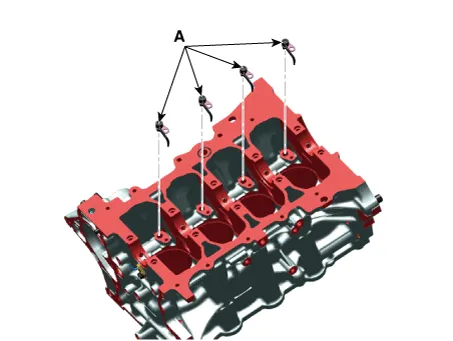
1.Using a gasket scraper, remove all the gasket material from the top surface of the cylinder block.
2.Using a soft brush and solvent, thoroughly clean the cylinder block.
3.Inspect the top surface of cylinder block for flatness.Using a precision straight edge and feeler gauge, measure the surface contacting the cylinder head gasket for warpage.
Flatness of cylinder block gasket surface :Less than 0.05 mm (0.0020 in.) for total areaLess than 0.02 mm (0.0008 in.) for a section of 100 mm x 100 mm (3.9370 in x 3.9370 in.)
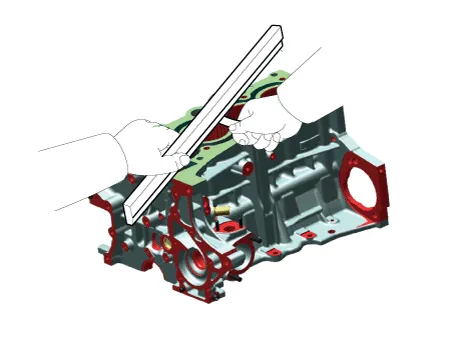
4.Visually check for scratches on the inside surface of the cylinder bore and replace the cylinder block if any noticeable scratch is detected. If deep scratchs are present, replace the cylinder block.
5.Using the cylinder bore gauge, measure the cylinder bore’s inner diameter to the axial and axial perpendicular directions.
Cylinder bore diameter : 75.60 - 75.63 mm (2.9764 - 2.9776 in.)
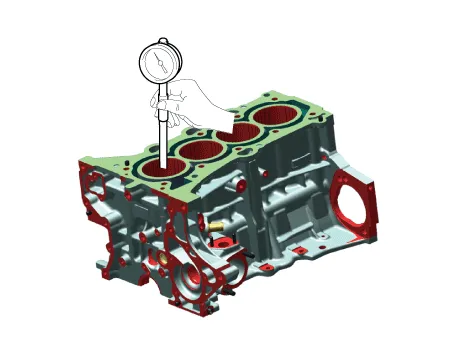

• Thoroughly clean all parts to assembled.
• Before installing the parts, apply fresh engine oil to all sliding and rotating surfaces.
• Always use new gaskets, O-ring and oil seals.
1.Install the piston cooling oil jets (A).
Tightening torque : 8.8 - 12.7 N.m (0.9 - 1.3 kgf.m, 6.5 - 9.4 lb-ft)
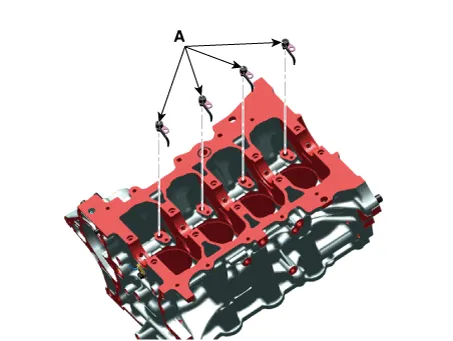
2.Install the crankshaft.(Refer to Cylinder Block - "Crankshaft")
3.Check the crankshaft end play.(Refer to Cylinder Block - "Crankshaft")
4.Disconnect the lower crankcase and check crankshaft bearing oil clearance.(Refer to Cylinder Block - "Crankshaft")
5.Install the piston and connecting rod assembly.(Refer to Cylinder Block - "Piston and Connecting Rod")
6.Check the connecting rod bearing cap oil clearance.(Refer to Cylinder Block - "Piston and Connecting Rod")
7.Check the connecting rod end play. (Refer to Cylinder Block - "Piston and Connecting Rod")
8.Assemble the other parts in the reverse order of disassembly.

• In case the cylinder block is replaced with a new one, select the proper crankshaft main bearing and the piston according to the crankshaft journal bore mark and the cylinder bore mark on the cylinder block.
• Crankshaft main bearing selection(Refer to Cylinder Block - "Crankshaft")
• Piston selection(Refer to Cylinder Block - "Piston and Connecting Rod")
Other information:
Hyundai Accent (HC) (2017 - 2022) Service Manual: Cowl Cross Bar Assembly
- Component Location 1. Cowl cross bar assembly - Replacement • Put on gloves to prevent hand injuries. • When removing with a flat - tip screwdriver or remover, wrap protective tape around the tools to prevent damage to components. • Use a plastic panel removal tool to remove interior trim pieces without marring the surface.Hyundai Accent (HC) (2017 - 2022) Service Manual: Ignition Coil
- Specification ItemSpecification Rated Voltage (V)13.5 Operation Voltage (V)6 - 16 ItemSpecification Engine Speed (RPM)100020003000400050006000 Dwell Time (ms)3.43.43.42.92.72.5 Secondary Coil Voltage (kV)40 ↑40 ↑40 ↑40 ↑40 ↑38 ↑ - Description An ignition coil is an induction coil in an engine's ignition system which transforms the battery's low voltage to the high voltage needed to create an electric spark in the spark plugs to ignite the fuel.
Categories
- Manuals Home
- Hyundai Accent Owners Manual
- Hyundai Accent Service Manual
- New on site
- Most important about car


